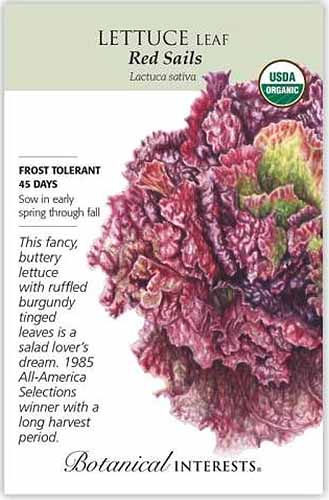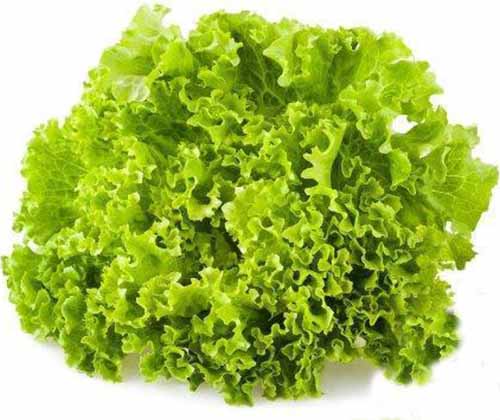How and When to Harvest Leaf Lettuce
Leaf lettuce is one of the fastest-maturing vegetables you can plant in your garden or in a container. The seeds are inexpensive, too, and it’s quite simple to sow and maintain them.
But all that convenience won’t mean much if you don’t pay close attention to when and how to harvest this type of Lactuca sativa.
The greens are tender, fresh, and crisp when picked at their peak. But they can get tough, wilt, or even rot if you don’t pick them in a timely fashion.
This cool-weather crop can also bolt when temperatures soar, becoming bitter after sending up stalks and flowers.
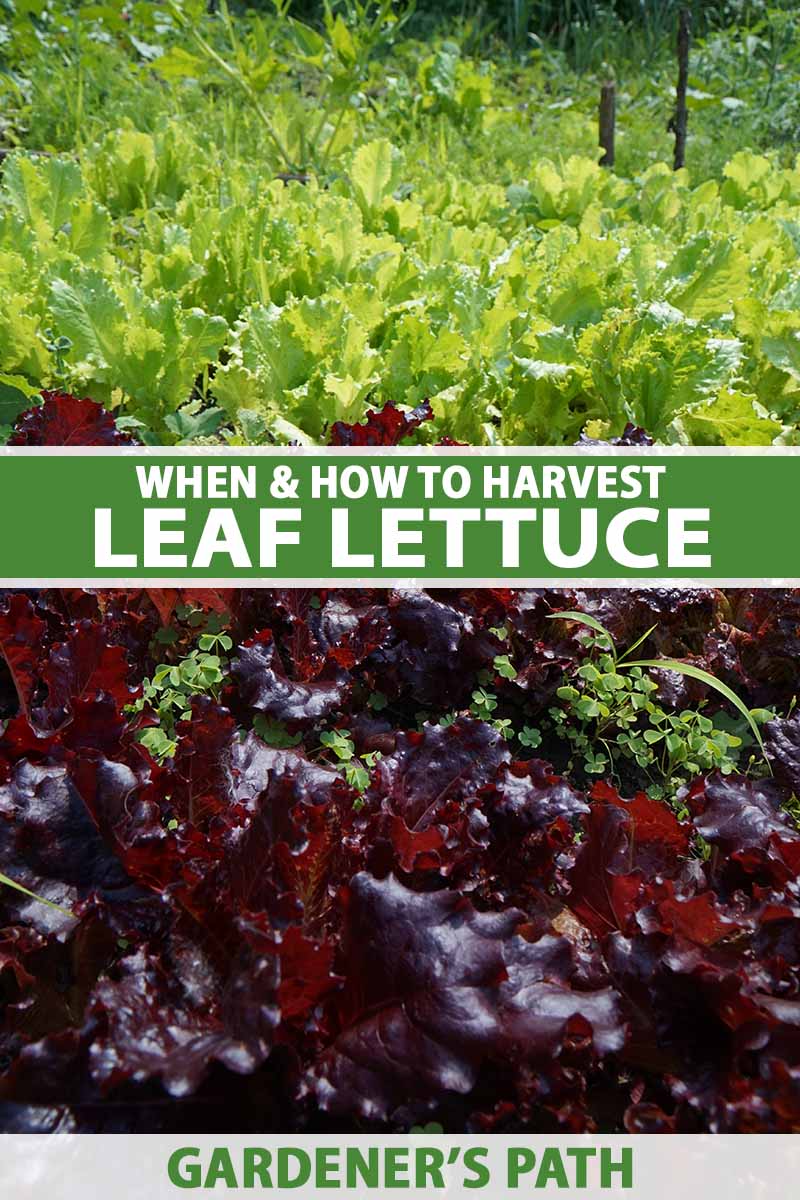
We link to vendors to help you find relevant products. If you buy from one of our links, we may earn a commission.
Fall crops may also succumb to frost or freezes, which may cause ice crystals to form and break the cells in the plant tissue, leaving you with dead, inedible leaves.
I’m here to help you plan so you can avoid harvesting in extreme weather. I’ll also cover ways to sidestep the issues that may arise when you pick improperly or too early.
Trust me, you’ll pick up these pointers quickly, and then nothing will get in the way of enjoying fresh greens on an ongoing basis, whether you’re aiming for baby or full-size leaves.
Here’s what to expect:
What You’ll Learn
Plan Before You Plant
Picking up a random packet of seeds and sowing them sometime in the spring is one way to plant leaf lettuce, and you may be able to grow a modest amount with that approach.
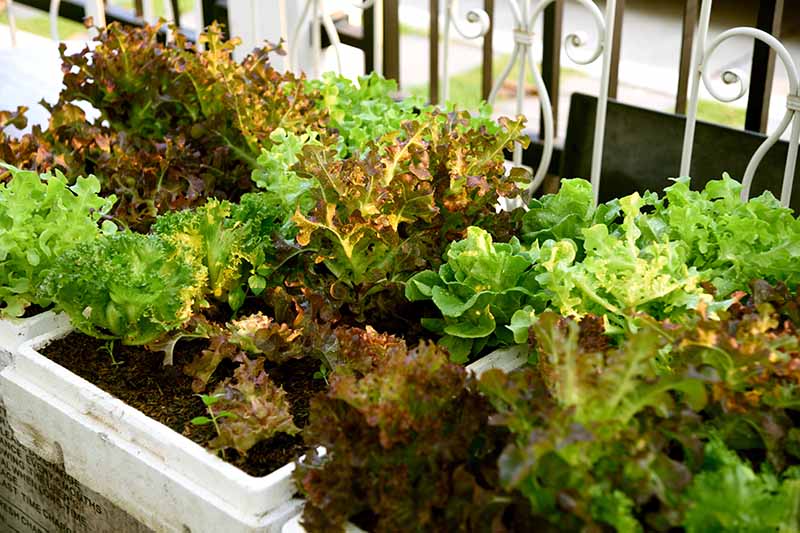
But you can greatly increase your odds of producing a bountiful crop with maximum flavor when you plan your harvest before you sow, and even ahead of buying your seeds.
Here are some points to ponder as you craft your strategy:
How You’ll Use the Lettuce
Before dropping the first seed or transplant into the garden, set your goals. First, determine how much lettuce you and your household can eat.

Bear in mind that this homegrown veggie can grow rapidly and it won’t “hold” for a long time after it reaches the size you prefer, so you’ll only want to sow or transplant as much as you’ll be able to consume.
Are you planning to join the three-salads-a-week club this spring? Or do you have your heart set on harvesting baby greens to toss with lemon juice and olive oil, and heap on pizza slices?
Your intended use for the produce will also guide your sowing approach, and ultimately, your harvest strategy.
When you’ll mostly depend on lettuce for making healthy wraps or sizable salads, you’ll want to allow plenty of time to grow the leaves so they’re big enough to wrap around taco fillings or to make a substantial salad.
Baby leaves have their place, but it takes a lot of them to produce even a couple of cups of greens.
For the biggest yields, carefully select a variety that will mature before your weather turns too hot. Also choose a type that will grow quickly enough to pick ahead of cold weather that will freeze the plants.
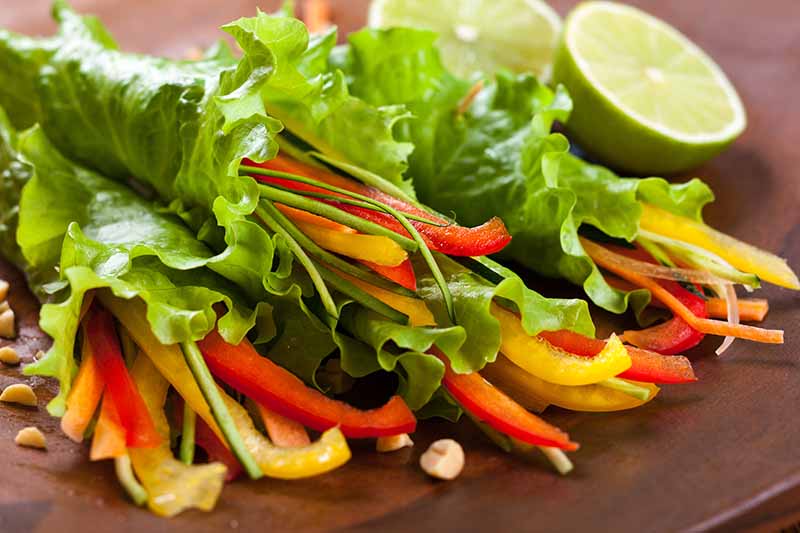
When you envision eating leaf lettuce as microgreens or baby greens, you’ll have more flexibility for sowing and selecting a cultivar to grow.
Just about any type will produce microgreens in the space of 10 to 14 days, and baby greens a couple of weeks later. That means you can sow them just a few weeks ahead of the hot temperatures, or ahead of your area’s average first frost date.
You can also opt to grow your tiny-leaf harvest in containers, which are simpler to move indoors, into shade, or to cover if hot weather or a hard freeze is predicted.
Baby leaves can also more easily withstand freezing temperatures without forming ice crystals than their full-size counterparts. But if you’re thinking this sounds like harvesting lettuce while it’s young and small is the only way to grow it, I can assure you that you can make a full-size harvest work, too.
In fact, when you sow the seeds thickly, you can thin the baby leaves to eat early in the season, and let the others reach full size later.
The main takeaway is this: When you’d like to enjoy some full-size leaves, you must sow a variety that has time to get big. We’ll look at making that selection next.
Time to Maturity
Any seed packet should specify the number of days to maturity for full-size leaves, which ranges from 40 to 70 days for leaf lettuce, but averages 50 to 55 days.
For spring sowing, use this number to count back from the point when temperatures will start entering the 70 to 80°F range, which can cause most types of lettuce to flower and produce seed, which can trash the flavor as well.

Of course, lettuce might also bolt in the weeks after germination if temps plummet below 50°F. You can learn more about bolting and why lettuce may become bitter in our guide. (coming soon!)
Loose-leaf varieties are less likely to get leaf-tip scald or languish in the heat than heading types, but even they can only hack it for a few days in the 80 to 85°F range.
Particularly if you live somewhere where Jack Frost arrives in autumn, or if it’s already pretty hot in late spring, choose a fast-maturing type to grow if you’d like to produce a supply of large leaves.
‘Red Sails,’ for example, produces baby leaves in 20 days and is fully grown in 45 days. It develops bronzed-tipped crinkly green leaves that reach 10 to 12 inches high, and spread about the same distance.
‘Red Sails’ seeds are available from Botanical Interests in one-gram packets.
‘Green Ice’ also reaches maturity in 45 days, with a final height of 10 to 12 inches. It’s slow to bolt, too, and crispier than most other leaf types of lettuce.
‘Green Ice’ seeds are available from True Leaf Market in a variety of package sizes.
Local Growing Conditions
To increase the likelihood that you can harvest leaves after they reach full size and before they bolt or freeze, schedule sowing in the appropriate time frame.

Some folks who live in warm areas extend this window by planting varieties that will withstand summer’s heat without bolting.
There are also loose-leaf varieties bred specifically for those growing in colder areas. ‘Grand Rapids,’ for example, produces extra-large, frilly leaves that mature in 55 days, and can withstand temps as low as -35°F.
‘Grand Rapids’ seeds are available in various packet sizes and in bulk up to 25 pounds from True Leaf Market.
If you know your local temperature range might not allow for a late spring or early summer harvest, consider sowing your crop in part shade so it will last longer in the warm months without bolting.
You can also start seeds indoors a few weeks ahead of your growing zone’s average last frost date, or purchase transplants for early spring. This will hasten the harvest in areas with short seasons.
Learn more helpful techniques for sowing and growing loose leaf lettuce in our guide.
You can also plan to protect the plants as winter weather moves in, either with hoops, row covers, or cold frames. There are more suggestions for protecting your late-season greens crop in our guide.
But in general, the simplest plan is to grow only the cultivars that will be able to reach maturity in plenty of time, or to choose to plant in containers or grow this tasty vegetable as microgreens.
Harvest Baby Leaf Lettuce
When you only want to eat them as tiny microgreens, it’s simple to pick loose leaf types of L. sativa.
This is a “one and done” process, where you use clean scissors or a sharp knife to cut the first true leaves when they’re one-half to two inches tall.
They will not regrow,so you’ll need to sow more every 10 to 14 days for an ongoing harvest.
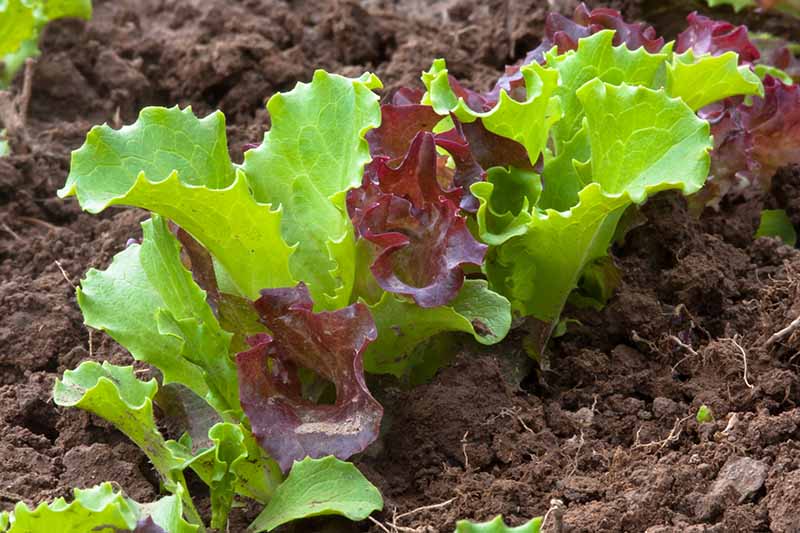
The baby leaves are ready to pick at three or four inches tall. Note that they’ll grow that large in about 21 to 28 days in the spring, but they could take an additional week or two to reach that height in cooler temps.
To harvest, clip them about an inch above the growing point at the crown where the aboveground plant meets the soil.
If you opt to cut only the outer leaves, the inner core will keep getting taller, and you’ll be able to harvest those leaves at a larger size.
You can also slice off the entire plant at the baby leaf stage. The base you leave behind may sprout anew, with additional young lettuce emerging that’s ready to pick in another 10 to 15 days.
Do make sure to keep up with watering once you start making those cuts, so the plant will stay healthy and the new leaves will be flavorful and crisp. Water only at the soil level, and avoid sprinkling the leaves.
For my money (and effort expended), I only try this “cut and come again” approach once per season. After the second cutting, I find the new growth isn’t as tender as freshly-sown lettuce, so I prefer to focus on successive planting over repeated cuttings taken from the same plants.
To learn more about succession planting, see our guide.
When and How to Pick Full-Size Leaves
Refer back to your seed packet to get an idea of when the cultivar you’re growing will reach full size, and also start checking on the plants at least a week before the predicted maturity date.
If you’re aiming to pick leaf lettuce at its full height for salads and to make lettuce wraps and such, monitor it closely.
Your goal is to pick it long before it sends up stalks and starts forming the buds that will turn to flowers, but not too long before it has reached its mature size for the variety you are growing.

Between bolting and the pests that may afflict your lettuce the longer it stays in the ground, one it’s past a certain point, bigger is not better.
L. sativa is in a category with mizuna, zucchini, and some other edible crops such that not only are the overgrown veggies less tasty, they are often completely inedible.
If you have any doubt, pick it a few days or even a couple of weeks early instead of letting it get too big and turn bitter or woody.
When the leaves have grown to their full height, go ahead and pick them all, rather than attempting a second growth from the same plants. And remember that if you are growing different varieties, these may mature at different rates and grow to different sizes.
Full disclosure: It is possible to regrow leaves from the core that you’ve left in the ground, but they usually aren’t particularly tender.
I find it’s more beneficial to use the same garden space – and your precious time – to instead plant a second batch of full-size leaf lettuce by sowing seed again in late summer for an autumn harvest.
Or, switch things up and sow seeds for baby leaves or microgreens before the growing season comes to an end, versus attempting to grow a second set of fully mature non-heading lettuce from the same plants.
To reap these salad greens, slice them off the plant about an inch from the soil line.
Use a sharp kitchen knife or garden shears to cut them a couple at a time, or to cut the whole plant at once.
You can also dig up the entire plant, shake off any dirt, and then sever the roots from the core once it’s out of the ground.
Immediately till the roots and core into the garden bed, or pull them up and add them to the compost pile. If they hang out in the garden, they might rot above the soil line or attract insect pests.
When prolonged hot weather above 80°F is in the forecast, even if the leaves are still just half the desired height, go ahead and pick them. It’s better to have a smaller yield of younger lettuce than waiting on the bigger size that might taste awful.
If you can swing it, harvest in the early morning, when the leaves are at their crispest and coolest.
When you must pick during a warmer part of the day, make sure to cool the lettuce immediately after you cut it, either by placing it in the fridge covered loosely with a plastic grocery store bag, or by resting it on top of a bowl containing a few ice cubes ahead of storing in the vegetable crisper.
Leaf No Lettuce Unpicked
Leaf lettuce is such a versatile homegrown vegetable, enhancing the nutrition, flavor, and texture of myriad foods from wraps and salads to sushi and deep-dish pizza.
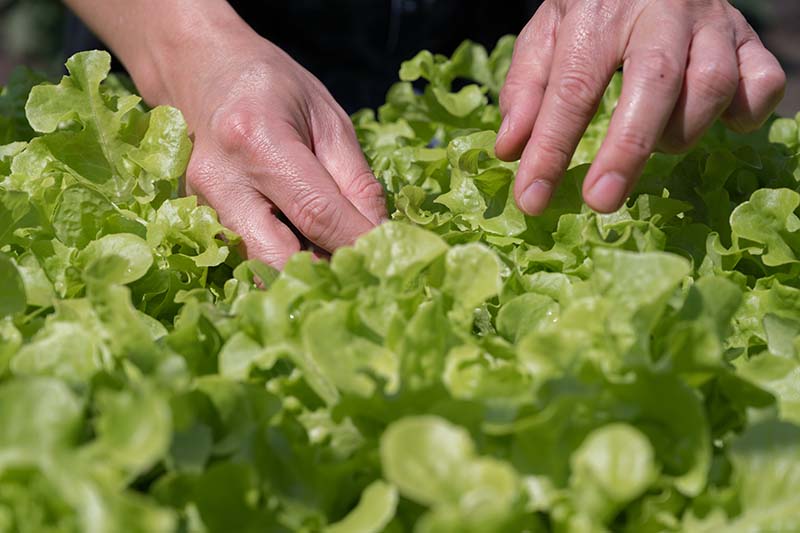
I would still choose to grow it even if it wasn’t so easy to care for. One part of the appeal is practical, the other epicurean.
For me, as a cook and gardener, the only thing better than knowing I’ve got an ample supply of the leaves is taking the extra steps that allow me to pick and enjoy them at their prime.
If you have experience with this type of harvest, could you kindly share any tips you’ve learned or questions you may have? The comment section below awaits your input!
And if you’d like to learn even more ways to grow the best crop for your salad bowl, check out these lettuce guides next:

